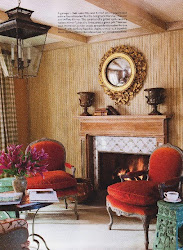With materials from the Home Improvement Store
This lonely little kitchen corner, in our Guest Cottage, needed a bit of "interest".
This lonely little walk into my cellar needed a little humph.
The hall fireplace needed a textured chimney piece.
The entrance hall needed a stone wall.
Empty spaces above windows needed a trumeau.
The "Fresco" to the Cellar.
In a hallway of the Castello Estense, Ferrara, Italy, you can admire an ancient Fresco at close quarters.
What a surprise! Except for the image, my frescoes have the same texture and appearance as those that I have painted and have shared with my students at our local college workshop.
All of the above examples I have created with dry wall compound and builders sand.
Here is how to paint a fresco swag.
Mix 12 cups of builders sand with one box of dry wall compound.
Apply with trowel in broad strokes (not circles).
Let dry, draw design onto wall with acrylic paints.
Note: You can use a stencil if you're not sure of your success in free hand painting.
When dry, cover (yes) your art work with a thin layer of your dry wall mixture. Let dry. Wet an ordinary kitchen sponge and scrub across the parts you want to reveal or " bring out".
Last layer, mix dark beer with colorant (artist gouache, universal tints, or dirty paint water) and with large soft brush, cover the entire surface. Use colors such as burnt umber and burnt sienna for an antique look.
Have a wonderful weekend my dear
Blogging Friends,
Gina





























Dear Gina,
ReplyDeleteThanks for your tips on antiquing, and there's no better proof of their success than your own house! I can imagine that the technique you used for the route to the cellar would be equally successful in recreating a Pompeiian room.
Gina,
ReplyDeleteThis is all very beautiful! I love the swag and I actually think that you are better off without stencils.
I love all the work you did and the lovely colours you used. How beautful!
Have you been to Pompeii' Some of the frescos, there are still as bright as they used to be when Pompeii wasn't a ghost city.
Thank you for sharing so much beauty and advice. We have a new house in Italy and I would live to add my own "touches" to it. My husband is an artist and doesn't trust me, though!
CIAO!
ANNA
xx
Dear Mark, Absolutely. This recipe works well and the sand keeps the Fresco from cracking. It really is an easy texture. What I like about it is that you can take up where you left off without showinbg any marks. You're a hands on gentleman, why not give it a try.
ReplyDeleteDear Anna, Yes I have seen the fresoes of Pompeii and several others while on our many trips to Italy. I was especially impressed with Giotto's work in the Scrovegni chapel in Padua and what about those of Assisi.
ReplyDeleteWhy not try a fresco, one that is small and can hang in your new Italian house. It can be treated like a painting. Stencils do help when your'e not sure of your design skills. Stencils can be enhanced to make them look as if they were painted freehand. And besides, a lot of the design will be removed, giving it a mysterious look, sort of as if you had found it in an old ruin. ox, Gina